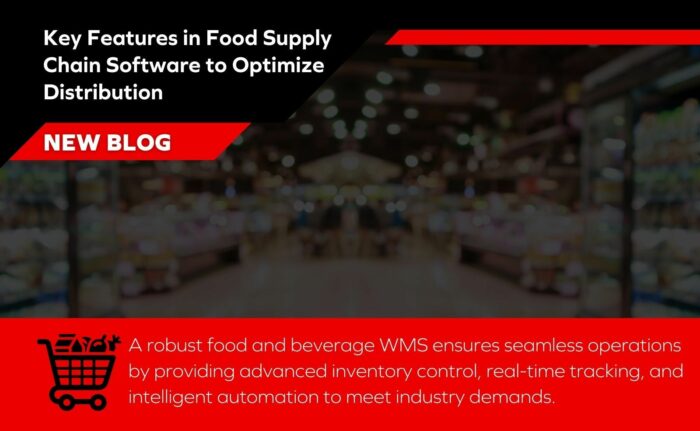
As modern warehouses become more automated, operators need effective software—whether that’s a warehouse management system (WMS), warehouse control system (WCS), or warehouse execution system (WES)—to manage their distribution processes. Automation, for example, is great for driving efficiencies, but all of those robotics systems require software to tell them what to do, when to do it, and how to do it. Here’s a thorough WMS vs. WCS vs WES comparison, and tips on selecting the best software for your operational needs:
- What is a WMS?
- What is a Warehouse Control System (WCS)?
- What is a Warehouse Execution System (WES)?
What is a WMS?
A Warehouse Management System (WMS) is used for exactly what it sounds like: managing a warehouse. Essentially all the processes that occur within the four walls of a warehouse, distribution center, or a logistics center, are driven the warehouse management system. It helps companies manage and drive processes, collecting data that can be used to plan short-term and long-term, and become more cost efficient.
Warehouse operations like receiving, put-aways, order fulfillment, shipping, and inventory management are commonly managed by a warehouse’s WMS.
What is a Warehouse Control System (WCS)?
A WCS, or Warehouse Control System, is a type of software used to direct and coordinate automated material handling equipment. Some common types of automated material handling equipment include carousels, order-picking robots, AS/RS systems, and AGVs.
Four Main Components Involved in Warehouse Automation
- The actual equipment (i.e., AS/RS, Conveyors, VLM’s, etc.)
- The controllers that move the equipment
- A material flow control system to coordinate the movement of equipment
- WCS: the software component that handles the logic of the MHE
How Do They Work Together?
In years gone by, each piece of automated material handling equipment would come with its own piece of warehouse management software provided by either the company that manufactured it or by the integrator that installed the system. That WCS software would run the logic within that specific component (e.g. – how pallets are stored within the AS/RS system, in which bin its stored, etc.) whereas the warehouse management system would manage the overall warehouse functions, helping determine how to best use warehouse associates, capturing data from tasks carried out across the warehouse, and sending the relevant portion of the work to the WCS to execute.
In a perfect world, each WCS would be seamlessly tied into the WMS so that the systems could effectively coordinate automation and labor performed by associates to be safe, efficient, and effective. Unfortunately, perfect integrations are very rare, and as you add more automation systems, you end up with more complexity. In addition to that, visibility and optimization of resources may not be optimal.
What is a Warehouse Execution System (WES)?
WES, or Warehouse Execution System, is a relatively new term and, really, a relatively new idea. A warehouse execution system is used to manage, synchronize, and orchestrate both tasks driven by automation and human assigned tasks to create better synergy and coordination between humans and machines. The objective is a much more efficient operation that works seamlessly and is driven by a single engine.
Rather than using a WCS to manage automation and a WMS to manage other warehouse functions, a WES is a type of software that handles the work that both WMS and WCS were responsible for overseeing from a single system.
Warehouse Management Software Doesn’t Have to Be So Complicated
A great WES gives you business logic and interconnectedness that a WMS/WCS combination generally doesn’t offer.
Imagine that you’re in a large warehouse. People are receiving and cross-docking freight, people are picking orders, AS/RS are moving pallets, people and robots are both filling orders, conveyors are moving items around the warehouse to position them for shipping, and people are loading trailers. A WES takes into account all those components, applies business logic, and shows you how to make operations more efficient, safer, and faster.
The e-commerce boom combined with supply chain issues mean that many warehousing operations are growing more complex to meet the needs of their customers. A WES allows companies to actually remove some of the complexity while improving functionality by providing all the features of a WCS and a WMS in one control tower.
Benefits of Using a WES
There are several benefits to switching from a WMS and WCS model to a warehouse management software like WES. Some of them include:
- Less complexity – That makes for a system that’s easier to use and therefore easier to train people to use.
- Lower cost – One system costs less in terms of money, time, and maintenance.
- Fewer integrations – When you’re using one system instead of several, you can implement and maintain fewer integrations.
- Better visibility – You can see everything in one system and data is all in one place instead of bouncing around, making it easier to see what’s happening and how you can strategize from there.
Wondering whether a WMS, WCS or WES could help streamline your warehousing operations and help you gain efficiency and scale? Reach out to the team at Made4net to learn how our supply chain solutions can do just that.


